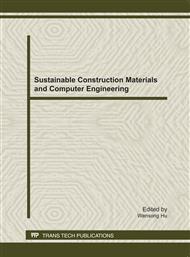[1]
H. A. Eschenauer, N. Olhoff, Topology Optimization of continuum structures: A Review, Applied Mechanics Review, 2001, vol. 54, pp.331-390.
DOI: 10.1115/1.1388075
Google Scholar
[2]
G. I. N. Rozvany, Aims, scope, methods, history and unified terminology of computer-aided topology optimization in structural mechanics, Struct Multidisc Optim, 2001, vol. 21, pp.90-108.
DOI: 10.1007/s001580050174
Google Scholar
[3]
Z. LUO, L. CHEN, Y. HUANG, Topological Optimization Design for Continuum Structures, Advances in Mechanics, 2004, vol. 34, no. 3, pp.463-476. (in Chinese).
Google Scholar
[4]
F. XU, J. RONG, Topology Optimization of Structures under Multiple Loads, Mechanics and Practice, 2004, vol. 26, pp.50-54. (in Chinese).
Google Scholar
[5]
M. P. Bendsoe, Optimal shape as a material distribution problem, Structural Optimization, 1998, vol. 1, pp.193-202.
Google Scholar
[6]
Altair Company, Altair/Hypermesh User's Guide, Beijing: mechanical industrial press, (2007).
Google Scholar
[7]
Kaiping Yu, Chuanyue Zhou, Huifeng Tan, HyperMesh From the beginner to the expert, Beijing: Science Press, (2005).
Google Scholar
[8]
Qing LIU, Xianjun HOU, Structure Topology Optimization Design of Vehicle Parts Based on HyperMesh/ OptiStruct, Equipment Manufacturing Technology, 2008, vol. 10, pp.42-44. (in Chinese).
Google Scholar
[9]
Dongjie Qin, Topology Optimization Design of Vertical Arm for a Certain Cross-country Car, Jilin: Jilin University, 2007. (in Chinese).
Google Scholar
[10]
R. B. Harber, C. S. Jog, M. P. Bendsoe, A new approach to variable-topology shape design using a constraint on perimeter, Structural Optimization, 1996, vol. 11, pp.1-12.
DOI: 10.1007/bf01279647
Google Scholar
[11]
Sigmund, J. Petersson, Numerical instabilities in topology optimization: A survey on procedures dealing with checkerboards, mesh-dependencies and local minima, Structural Optimization, 1998, vol. 16, pp.68-75.
DOI: 10.1007/bf01214002
Google Scholar
[12]
Yuan ZHEN, Changchun WU, Shoubing ZHUANG, Topology optimization of Continuum Structure Using Hybrid Elements and Artificial Material Model, Journal of China University of Science And Technology, 2001, vol. 31, no. 6, pp.694-699.
Google Scholar
[13]
L. Li, The Research of Structure Topology Optimization Based on Variable Density Method, Changchun: Jinlin university, 2007. (in Chinese).
Google Scholar
[14]
Xiteng Liu, D. Chan, B. Gerbrandt, Bearing capacity of soils for crawler cranes, Can Geotech J, 2008, vol. 45, pp.1282-1302.
DOI: 10.1139/t08-056
Google Scholar


